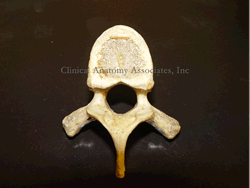[UPDATED] The word [pedicle] is a derivative from the Latin [pediculus] meaning “a small foot”, a “stem”, or a “stalk”. The Latin term [pediculus] is itself a derivative of [pes/pedis] meaning “foot”.
[Pedicle] is also used to denote structures that lie at the root of “foot” of an organ, as in the “renal pedicle” (an older anatomical term) or in the pedicle of a sessile tumor. It is also used in surgery, to denote the vascular pedicle or “stalk” of a free tissue graft.
Since a pedicle is also the “foot” of an arch, the term has also been used to denote the base of the vertebral arch. Thus explained, each vertebra has bilateral bony bridges between the vertebral body anteriorly and the laminae posteriorly. These are the vertebral pedicles, which form the lateral walls of the vertebral canal.
The vertebral pedicles have different characteristics (width, length, angulation) depending on their vertebral level. This is important for spine surgery where pedicle screws are used:
• Lumbar vertebra: has a thicker, wider pedicle that tends to angulate posterolaterally
• Thoracic vertebra: has a thinner pedicle that looks almost anteroposteriorly
• Cervical vertebra: the pedicle is very small and thin, angles quite laterally, and forms the medial border of the transverse foramina.
The accompanying image is an inferior view of a thoracic vertebra showing the location of the vertebral pedicles. Click on the image for a larger version.
Additional information: “Vertebral pedicle anatomy in relation to pedicle screw fixation: a cadaver study” Chaynes et al. Surg Rad Anat (2001) 23:2, 85-90
Image property of: CAA.Inc.. Photographer: D.M. Klein.




